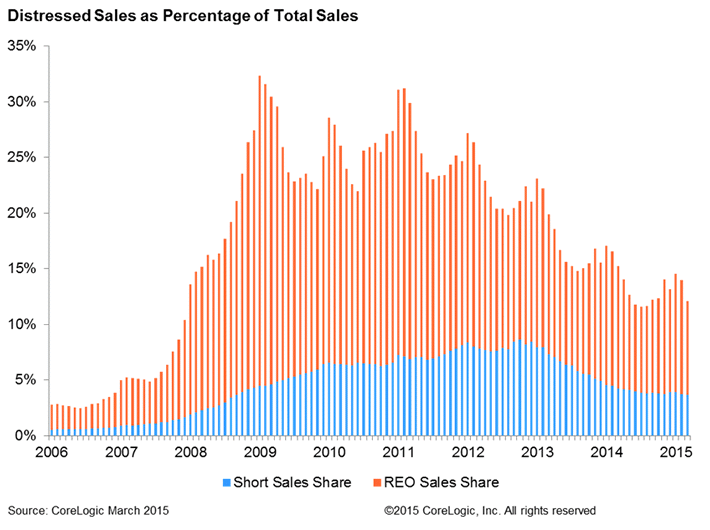The percentage of total home sales coming from distressed inventories continues to drop. CoreLogic said on Monday that short sales and sales of owned real estate (REO) fell 3.2 percentage points from March 2014 to March 2015 and were down 1.9 percent from February to March.
REO properties accounted for 8.4 percent of home sales in March and short sales made up 3.7 percent for a total distressed property share of 12.1 percent. CoreLogic said that March is typically a month in which distressed sales fall due to seasonal factors, but this March had the lowest share of any March since 2007.
At the peak in January 2009 distressed sales totaled 32.4 percent of all sales and REO sales for 27.9 percent. The continuing decrease in REO sales has accounted in part for rising home prices since bank-owned properties typically sell at a larger discount than short sales. CoreLogic said there will always be some amount of distress in the housing market but the pre-crisis share of distressed sales was traditionally about 2 percent. If the current year-over-year decrease in the distressed sales share is maintained, that share would reach its "normal" 2-percent mark in mid-2017.

Michigan had the largest share of distressed sales in March at 22.1 percent followed by Florida (22 percent), Illinois (20.1 percent), Maryland (19.5 percent) and Connecticut (19.1 percent). Nevada had an 8 percentage point drop in its distressed sales share from a year earlier, the largest decline of any state while the distressed share of California sales has fallen 57.6 percentage points from its January 2009 peak of 67.5 percent. While some states stand out as having high distressed sales shares, only North Dakota and the District of Columbia are even close to their pre-crisis numbers (within one percentage point).
Of the 25 largest Core Based Statistical Areas (CBSAs) based on loan count, the three areas with the largest share of distressed sales were in Florida; the Orlando area at 24.6 percent, followed by Miami (24.2 percent) and Tampa-St. Petersburg-Clearwater (23.5 percent). Chicago (22.9 percent) and Baltimore (19.2 percent) rounded out the top five.
Atlanta had the largest year-over-year drop in its distressed share, falling by 8.8 percentage points in March 2014 to 15.7 percent in March 2015. The CBSA with the largest overall improvement in its distressed sales share from the peak was Riverside-San Bernardino where distressed sales made up 76.3 percent of all sales in February 2009 compared to the March 2015 share of 12.9 percent.







